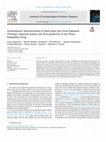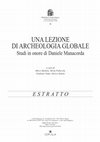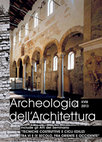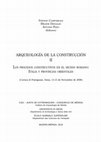Papers by Cynthia Mascione
Ricerca, valorizzazione e management: tra passato e futuro del Parco archeologico di Baratti e Populonia, Atti del Convegno per il ventennale del Parco (Baratti, 11-12 luglio 20189, 2021
>>> 90 >>> Ricerca, valorizzazione e management: tra passato e futuro del Parco archeologico di B... more >>> 90 >>> Ricerca, valorizzazione e management: tra passato e futuro del Parco archeologico di Baratti e Populonia <<< 1 >>> delle mura), con l'indicazione dei saggi di scavo eseguiti durante il Progetto Ales (in retino grigio, lettere A-F) e dei punti in cui sono stati individuate le scale (nn. 1-2) e la viabilità secondaria (nn. 3-5). I tratteggi indicano i tracciati ricostruiti in base alle emergenze.

Journal of Archaeological Science: Reports, 2022
This paper presents a chemical characterization by means of WDXRF and mineralogical characterizat... more This paper presents a chemical characterization by means of WDXRF and mineralogical characterization by means of XRD of 21 individuals of black gloss pottery from the excavations on the acropolis of Populonia. The results shed new light on the circulation of pottery to this major urban centre in North Etruria during the Roman Republican period, while they also suggest the likelihood of local manufacture. In particular, we identify at Populonia four different black gloss productions that can be archaeometrically defined as Campanian A, Volterra, Etrusco-Latial 1 and a possible local production of ceramics belonging to the Petites Estampilles Group, active in the late fourth and third centuries BCE. Once thought to be a workshop located at Rome itself, this class is now understood as a diffuse network of workshops located in South Etruria and Latium producing pottery of similar technology and style. The present study potentially extends the map of its production to North Etruria in a region at that time newly incorporated into the expanding Roman Republican empire.
Gradus 14.1, 2019, 2020
Nel contributo sono presentati i risultati degli ultimi scavi (2018-2019) realizzati nell'acropol... more Nel contributo sono presentati i risultati degli ultimi scavi (2018-2019) realizzati nell'acropoli di Populonia, alla base del terrazzamento ad arcate dell'edificio delle Logge e sulla terrazza superiore, dove già negli anni 2000 e 2005 era stato individuato un balneum.
Antico e non antico. Scritti multidisciplinari offerti a Giuseppe Pucci, a cura di V. Nizzo, A. Pizzo, 2018

Una lezione di archeologia globale. Studi in onore di Daniele Manacorda, a cura di M. Modolo, S. Pallecchi, G. Volpe, E. Zanini, 2019
This excavation was carried out by the Department of Archaeology of the University of Siena (Dani... more This excavation was carried out by the Department of Archaeology of the University of Siena (Daniele Manacorda, Emanuele Papi and myself) in collaboration with the Soprintendenza of Umbria. Our intervention was prompted by the discovery of ancient structures during the excavation of a trench in a private land. The site lays along the Via Flaminia, 5 km past Narni, in the direction of Terni. There were two different structures, a mausoleumand a balneum, 26 meters distant from each other. Both were robbed of their standing structures and of their decorative elements, probably on several occasions between the 5th century and the medieval period. Of the mausoleum only a row of travertine blocks and the interior concrete core remained. This formed the basement of an altar or aedicule tomb built between the 1stcentury BC and the 1stcentury AD belonging to a prominent family who probably owned a fundus in the surrounding area. The balneum was built between the end of the 3rd and the beginning of the 4th century AD, and it was probably connected with the cursus publicus. The structure was built after about a century of abandonment atop an older building dating to the second half of the Ist-2nd century AD and perhaps already related to the road and to the provision of services for travellers.

Sulle scorie provenienti dal sito archeologico di Le Gore è in corso uno studio chimico e mineral... more Sulle scorie provenienti dal sito archeologico di Le Gore è in corso uno studio chimico e mineralogico con lo scopo di definire a quale fase del processo produttivo vadano ricondotte. Vengono di seguito riportati i risultati preliminari. Le scorie sono state rinvenute nel sito di Pantani-Le Gore (SI), dove, in base agli itinerari di età romana ed altomedievale andrebbe collocata una statio romana. La vita della fase romana, in base ai materiali recuperati, sembra limitata al II-inizi III secolo d.C. Dopo circa due secoli di apparente abbandono, l'insediamento viene rioccupato alla fine del V secolo. L'abitato tardoantico-altomedievale, che si protrae per tutto il VI secolo, si installa in parte in corrispondenza del complesso imperiale ed in parte nell'area meridionale dello scavo. Proprio nell'area meridionale dello scavo sono state rinvenute 745 scorie di ferro da mettere in relazione con le attività metallurgiche verosimilmente testimoniate da due piccoli forni, d...
Santuarios Oppida Y Ciudades Arquitectura Sacra En El Origen Y Desarrollo Urbano Del Mediterraneo Occidental 2009 Isbn 978 84 00 08827 9 Pags 309 328, 2009
Localización: Santuarios, oppida y ciudades: arquitectura sacra en el origen y desarrollo urbano ... more Localización: Santuarios, oppida y ciudades: arquitectura sacra en el origen y desarrollo urbano del Mediterráneo occidental/coord. por Pedro Mateos Cruz, Sebastián Celestino Pérez, Antonio Pizzo, Trinidad Tortosa, 2009, ISBN 978-84-00-08827-9, págs. 309-328

in P. Pensabene, E. Gasperini (eds.), Interdisciplinary Studies on Ancient Stone, Proceedings of the X ASMOSIA Conference (Roma 21-26/05/2012), Roma 2015, pp. 55-62.
Recently (2000-2004) a First Style wall painting (end of
2nd century BC) was found in the Etrusc... more Recently (2000-2004) a First Style wall painting (end of
2nd century BC) was found in the Etruscan-Roman town
of Populonia (LI – Italy). The richness and variety of
marbling in the multicoloured courses of ashlar blockwork
are extremely interesting if compared to other contemporary
examples, up till now known, in Italy. The
marbling, especially for some types, resembles the real
stones surprisingly, not only for the realistic pattern but
also for the accurate modelling, the colours tones and
the smoothing and shimmering gloss of the surface. The
plasterers and painters had a great technical skill that allowed
to make a surface appearance very similar to real
marbles. The minero-petrographic analysis of the tectorium
and pigments, carried out in order to identify the
raw materials and the different painting techniques
used, have emphasized the great accuracy of the wall
painting.

Ricerche recenti condotte dall'Università di Siena sulle mura dell'acropoli della città etrusca d... more Ricerche recenti condotte dall'Università di Siena sulle mura dell'acropoli della città etrusca di Populonia hanno fornito nuovi dati per la definizione della cronologia e della tecnica costruttiva. Lo studio topografico del circuito e lo scavo della fossa di fondazione hanno portato a riconsiderare la cronologia tradizionale (fine VI-inizi V secolo a.C.) e a datare la costruzione delle mura al primo quarto del III secolo a.C. L'analisi degli elevati e la stratigrafia delle attività di fondazione hanno evidenziato le modalità e la strategia costruttiva dei cantiere edilizio. Nei prospetti delle strutture meridionali sono evidenti le linee di giunzione fra porzioni di muratura costruite indipendentemente e queste indicano come la costruzione sia stata eseguita da squadre diverse di maestranze. Inoltre, il confronto fra il settore meridionale e quello orientale ha evidenziato differenze strutturali e qualitative, riconducibili all'intervento di maestranze più o meno qualificate o forse a fasi diverse realizzate in condizioni di minore o maggiore urgenza.

At Populonia, a coastal settlement in Tyrrhenian Etruria, a joint study has been launched that lo... more At Populonia, a coastal settlement in Tyrrhenian Etruria, a joint study has been launched that looks at quarries of stone, particularly calcareous sandstone, and the buildings in which it was used, as part of a plan to reconstruct the production processes of ornamental and building stone and, in parallel, to understand their economic and social value for the urban community. Various methodologies were tested and integrated, particularly for the study of quarries, in order to reconstruct the organization of the extraction process and to make possible the comparison with the built environment: stratigraphic excavation, bi- and three-dimensional survey, cataloguing of quarrying traces, geophysical survey (seismic refraction), and mineralogical and petrographic analyses. Although calcareous sandstone has been used in squared blocks since at least the Orientalizing period (mid-seventh century BC) in upper class funerary buildings, a study of the traces of extraction in the Buche delle Fate quarry made it possible to identify the technical background of the workers and the procedures for extracting the blocks, datable to the reconstruction of the acropolis of Populonia between the late third to mid second century BC. Archaeometrical analyses allowed the stone material samples taken from buildings to be related with different quarry areas, revealing itself as the most reliable method for tracking the supply points of the calcareous sandstone for individual construction sites.
Mura di legno, mura di terra, mura di pietra:
si sottolinea la generale difficoltà di identificazione architettonica delle mansiones.






Uploads
Papers by Cynthia Mascione
2nd century BC) was found in the Etruscan-Roman town
of Populonia (LI – Italy). The richness and variety of
marbling in the multicoloured courses of ashlar blockwork
are extremely interesting if compared to other contemporary
examples, up till now known, in Italy. The
marbling, especially for some types, resembles the real
stones surprisingly, not only for the realistic pattern but
also for the accurate modelling, the colours tones and
the smoothing and shimmering gloss of the surface. The
plasterers and painters had a great technical skill that allowed
to make a surface appearance very similar to real
marbles. The minero-petrographic analysis of the tectorium
and pigments, carried out in order to identify the
raw materials and the different painting techniques
used, have emphasized the great accuracy of the wall
painting.
2nd century BC) was found in the Etruscan-Roman town
of Populonia (LI – Italy). The richness and variety of
marbling in the multicoloured courses of ashlar blockwork
are extremely interesting if compared to other contemporary
examples, up till now known, in Italy. The
marbling, especially for some types, resembles the real
stones surprisingly, not only for the realistic pattern but
also for the accurate modelling, the colours tones and
the smoothing and shimmering gloss of the surface. The
plasterers and painters had a great technical skill that allowed
to make a surface appearance very similar to real
marbles. The minero-petrographic analysis of the tectorium
and pigments, carried out in order to identify the
raw materials and the different painting techniques
used, have emphasized the great accuracy of the wall
painting.
The survey adopted a combination of different methods and techniques:
- DGPS survey,
- geophysical prospections of unexcavated areas,
- topographical survey of emerging structures,
- study of published documentation and archival records,
- 2D and 3D land-based and aerial photogrammetry.
The results of these activities led to the revision of Lixus plan. In particular, the survey and analysis of the archaeological stratification and building techniques of the city walls and of a quarter located on the eastern slope of the hill brought new light to the diachronical evolution of the city.
Paesaggi dell'Etruria romana
29 - 30 Giugno 2018
Comitato scientifico
Richard Hodges - American University of Rome
Daniele Manacorda - Università Roma Tre
Carolina Megale - Università di Firenze
Riccardo Rao - Università di Bergamo
Alessandro Sebastiani - University at Buffalo (SUNY)
MediTo è organizzato in collaborazione con l’Associazione culturale Past in Progress e con il patrocinio di:
Comune di Civitella Paganico
Centro Studi Città e Territorio
Ass. Cult. Past in Progress
Department of Classics - University at Buffalo (SUNY)
IEMA Institute of European and Mediterranean Archaeology (University at Buffalo)
American University of Rome